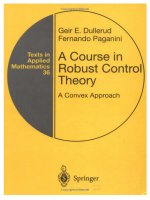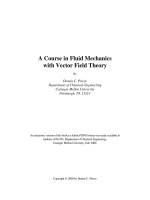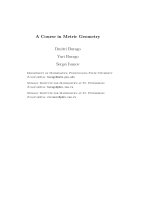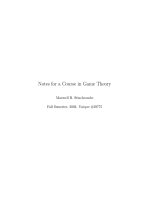Ebook A course in monetary economics - Sequential trade, money, and uncertainty: Part 1
Bạn đang xem bản rút gọn của tài liệu. Xem và tải ngay bản đầy đủ của tài liệu tại đây (939.01 KB, 214 trang )
A COURSE IN
MONETARY ECONOMICS
SEQUENTIAL TRADE, MONEY, AND UNCERTAINTY
Benjamin Eden
© 2005 by Benjamin Eden
350 Main Street, Malden, MA 02148-5020, USA
108 Cowley Road, Oxford OX4 1JF, UK
550 Swanston Street, Carlton, Victoria 3053, Australia
The right of Benjamin Eden to be identified as the Author of this Work has been asserted in accordance
with the UK Copyright, Designs, and Patents Act 1988.
All rights reserved. No part of this publication may be reproduced, stored in a retrieval system, or
transmitted, in any form or by any means, electronic, mechanical, photocopying, recording or
otherwise, except as permitted by the UK Copyright, Designs, and Patents Act 1988, without the prior
permission of the publisher.
First published 2005 by Blackwell Publishing Ltd
Library of Congress Cataloging-in-Publication Data
Eden, Benjamin.
A course in monetary economics : sequential trade, money, and uncertainty / Benjamin Eden.
p. cm.
ISBN 0-631-21565-4 (cloth : alk. paper)
ISBN 0-631-21566-2 (pbk. : alk. paper)
1. Money–Mathematical models.
2. Uncertainty–Mathematical models.
I. Title
HG221.E26 2005
332.4 01 51–dc22
2003020730
A catalogue record for this title is available from the British Library.
Set in 10/12 12 Dante
by Newgen Imaging Systems (P) Ltd, Chennai, India
Printed and bound in the United Kingdom
by MPG Books, Bodmin, Cornwall
For further information on
Blackwell Publishing, visit our website:
Brief Contents
Preface
Part I: Introduction to Monetary Economics
1 Overview
xiii
1
5
2 Money in the Utility Function
26
3 The Welfare Cost of Inflation in a Growing Economy
57
4 Government
72
5 More Explicit Models of Money
86
6 Optimal Fiscal and Monetary Policy
100
7 Money and the Business Cycle: Does Money Matter?
123
8 Sticky Prices in a Demand-satisfying Model
147
9 Sticky Prices with Optimal Quantity Choices
155
10 Flexible Prices
Part II: An Introduction to the Economics of Uncertainty
170
179
11 Preliminaries
182
12 Does Insurance Require Risk Aversion?
197
13 Asset Prices and the Lucas “Tree Model”
202
Part III: An Introduction to Uncertain and Sequential Trade (UST)
207
14 Real Models
210
15 A Monetary Model
250
vi BRIEF CONTENTS
16 Limited Participation, Sticky Prices, and UST: A Comparison
261
17 Inventories and the Business Cycle
280
18 Money and Credit in the Business Cycle
302
19 Evidence from Micro Data
313
20 The Friedman Rule in a UST Model
327
21 Sequential International Trade
333
22 Endogenous Information and Externalities
356
23 Search and Contracts
369
References
385
Index
395
Contents
Preface
xiii
Part I: Introduction to Monetary Economics
1 Overview
1.1
1.2
1.3
1.4
Money, Inflation, and Output: Some Empirical Evidence
The Policy Debate
Modeling Issues
Background Material
1.4.1 The Fisherian diagram
1.4.2 Efficiency and distortive taxes
1.4.3 Asset pricing
2 Money in the Utility Function
2.1 Motivating the Money in the Utility Function Approach:
The Single-period, Single-agent Problem
2.2 The Multi-period, Single-agent Problem
2.3 Equilibrium with Constant Money Supply
2.4 The Social and Private Cost for Accumulating Real Balances
2.5 Administrative Ways of Getting to the Optimum
2.6 Once and for All Changes in M
2.7 Change in the Rate of Money Supply Change: Technical Aspects
2.8 Change in the Rate of Money Supply Change: Economics
2.9 Steady-state Equilibrium (SSE)
2.10 Transition from One Steady State to Another
2.11 Regime Changes
2.12 Introducing Physical Capital and Bonds
1
5
5
8
13
14
15
18
21
26
26
28
33
34
36
36
37
38
41
41
43
45
viii CONTENTS
2.13 The Golden Rule and the Modified Golden Rule
Appendix 2A A dynamic programming example
3 The Welfare Cost of Inflation in a Growing Economy
3.1 Steady-state Equilibrium in a Growing Economy
3.2 Generalizing the Model in Chapter 2 to the Case of Growth
3.3 Money Substitutes
Appendix 3A A dynamic programming formulation
4 Government
4.1 The Revenues from Printing Money
4.1.1 Steady-state revenues
4.1.2 Out of the steady-state revenues
4.1.3 The present value of revenues
Appendix 4A Non-steady-state equilibria
4.2 The Government’s “Budget Constraint”
4.2.1 Monetary and fiscal policy: Who moves first?
4.2.2 The fiscal approach to the price level
4.3 Policy in the Absence of Perfect Commitment:
A Positive Theory of Inflation
5 More Explicit Models of Money
5.1 A Cash-in-advance Model
5.1.1 A two-goods model
5.1.2 An analogous real economy
5.1.3 Money super-neutrality in a one-good model
5.2 An Overlapping Generations Model
5.3 A Baumol–Tobin Type Model
Appendix 5A
6 Optimal Fiscal and Monetary Policy
6.1
6.2
6.3
6.4
The Second-best Allocation
The Second Best and the Friedman Rule
Smoothing Tax Distortions
A Shopping Time Model
7 Money and the Business Cycle:
Does Money Matter?
7.1 VAR and Impulse Response Functions: An Example
7.2 Using VAR Impulse Response Analysis to Assess
the Money–Output Relationship
47
53
57
57
58
64
69
72
72
72
73
75
76
78
81
81
82
86
86
87
89
92
94
96
98
100
100
103
109
112
123
125
127
CONTENTS ix
7.3 Specification Search
7.4 Variance Decomposition
135
142
8 Sticky Prices in a Demand-satisfying Model
147
9 Sticky Prices with Optimal Quantity Choices
155
9.1 The Production to Order Case
9.2 The Production to Market Case
10 Flexible Prices
10.1 Lucas’ Confusion Hypothesis
10.2 Limited Participation
Part II: An Introduction to the Economics of Uncertainty
11 Preliminaries
156
161
170
170
174
179
182
11.1 Trade in Contingent Commodities
11.2 Efficient Risk Allocation
185
190
12 Does Insurance Require Risk Aversion?
197
12.1 The Insurance-buying Gambler
12.2 Socially Harmful Information
13 Asset Prices and the Lucas “Tree Model”
Part III: An Introduction to Uncertain and Sequential Trade (UST)
14 Real Models
14.1 An Example
14.1.1 Downward sloping demand
14.1.2 Welfare analysis
14.1.3 Demand and supply analysis
14.2 Monopoly
14.2.1 Procyclical productivity
14.2.2 Estimating the markup
14.3 Relationship to the Arrow–Debreu Model
14.4 Heterogeneity and Supply Uncertainty
14.4.1 The model
200
201
202
207
210
210
215
218
221
224
226
227
228
231
233
x CONTENTS
14.5 Inventories
14.5.1 Temporary (partial) equilibrium
14.5.2 Solving for a temporary equilibrium
14.5.3 Full equilibrium
14.5.4 Efficiency
Appendix 14A The firm’s problem
Appendix 14B The planner’s problem
15 A Monetary Model
15.1
15.2
15.3
15.4
15.5
15.6
An Example
Working with the Money Supply as the Unit of Account
Anticipated and Unanticipated Money
Labor Choice, Average Capacity Utilization and Welfare
A Generalization to Many Potential Markets
Asymmetric Equilibria: A Perfectly Flexible Price Distribution is
Consistent with Individual Prices That Appear to Be “Rigid”
15.7 Summary of the Implications of the Model
16 Limited Participation, Sticky Prices, and UST: A Comparison
16.1
16.2
16.3
16.4
Limited Participation
Sticky Prices
UST
A Real Business Cycle Model with Wedges: Some Equivalence
Results
16.5 Additional Tests Based on Unit Labor Cost and Labor Share
17 Inventories and the Business Cycle
17.1
17.2
17.3
17.4
Introducing Costless Storage
Adding Supply Shocks
Testing the Model with Detrended Variables
Using an Impulse Response Analysis with Non-detrended Variables
to Test for Persistence
Appendix 17A The Hodrick–Prescott (H–P) filter
18 Money and Credit in the Business Cycle
18.1 A UST Model with Credit
18.2 Inventories Are a Sufficient Statistic for Past Demand Shocks
18.3 Estimating the Responses to a Money Shock
237
238
240
243
243
247
248
250
251
253
255
256
256
258
259
261
261
265
268
274
276
280
282
288
292
297
300
302
302
305
306
CONTENTS xi
18.4 Estimating the Responses to an Inventories Shock
18.5 Concluding Remarks
19 Evidence from Micro Data
19.1
19.2
19.3
19.4
19.5
A Menu Cost Model
The Serial Correlation in the Nominal Price Change
A Two-Sided Policy
Relative Price Variability and Inflation
A Staggered Price Setting Model
310
312
313
313
315
316
317
319
20 The Friedman Rule in a UST Model
327
20.1 A Single-Asset Economy
20.2 Adding a Costless Bonds Market
20.3 Costly Transactions in Bonds
327
330
331
21 Sequential International Trade
21.1 A Real Model
21.2 A Monetary Model
21.3 Exchange Rates
Appendix 21A Proofs of the Claims in the Monetary Model
Appendix 21B Example 7 in detail
22 Endogenous Information and Externalities
22.1 A Real Model
22.2 A Monetary Model
22.3 Relationship to the New Keynesian Economics
23 Search and Contracts
23.1 Search over Time
23.2 Random Choice of Markets
23.3 Capacity Utilization Contracts and Carlton’s Observations
333
334
341
348
350
353
356
356
361
367
369
369
371
375
References
385
Index
395
Preface
The aim of this book is to integrate the relatively new uncertain and sequential trade (UST)
models with standard monetary economics. I therefore combine exposition of well-known
material with that of new and sometimes yet unpublished. The exposition is at the graduate level but since mathematics is de-emphasized, it can and was used at the advanced
undergraduate level.
I wrote this book while teaching monetary economics during the period 1987–2002 at
the joint Master program of the Technion and the University of Haifa. I also taught earlier
versions at Florida State University (First year Ph.d. level, 2001) at the University of Chicago
(Second year Ph.d. level, 2002) and at Vanderbilt University (First and second year Ph.d. level,
2002–3). I have benefited from policy discussion at the Bank of Israel during the period 1992–7
where I was a consultant to the research department. This served as a reminder that monetary
economics is a slow moving field not because all the problems are solved but because there
are many unsolved problems that are difficult.
My interest in UST type models has started in 1979–80 while visiting Carnegie Mellon
university. Initially I was motivated by the observation that the standard Walrasian model is
incomplete because it uses the Walrasian tatonnement process to find the market clearing
price. As a result my earlier models focused on the question of who will gather information
about the market-clearing price. In these models sellers could buy information about demand
but there were informational externalities arising from the fact that advertised prices can
be observed by all sellers. These type of models were published in the years 1981–3 and
are discussed in chapter 22. I then moved to simpler models that abstract from information
acquisition. This simpler set-up proved to be rich enough and occupied most of my research
efforts. The motivation has also changed. Instead of complaining about the tatonnement
process I now focus on the performance of the model in explaining the monetary economy.
Since this book represents more than 20 years of effort it is difficult to remember and thank
all the numerous useful comments and discussions. I have benefited mostly from comments
made by students over the years. Ben Bental and Don Schlagenhauf read parts of an earlier
version of the manuscript and made useful comments. I have also benefited from comments
xiv PREFACE
and discussions with Rick Bond, Boyan Jovanovic, Bob Lucas and Michael Woodford. Michael
Bar provided excellent research assistance.
My wife Sveta contributed more than moral support and understanding. She has written a
Master thesis on the subject and simulated the UST model with inventories. I hope that this
book will also be of some interest to my daughter Maya and to my sons Michael and Ittai at
some point in the future. Finally, I want to thank my parents Shevach and Zahava Eden for
moral support and gentle push.
PART I
Introduction to Monetary
Economics
1 Overview
2 Money in the Utility Function
3 The Welfare Cost of Inflation in a Growing Economy
4 Government
5 More Explicit Models of Money
6 Optimal Fiscal and Monetary Policy
7 Money and the Business Cycle: Does Money Matter?
8 Sticky Prices in a Demand-satisfying Model
9 Sticky Prices with Optimal Quantity Choices
10 Flexible Prices
3
In the first part of this book we use standard monetary models to talk about the joint behavior
of nominal and real variables. We start with the long-run relationship focusing on the relationship
between money and inflation. The focus then shifts to the short-run relationship between money and
output. Special attention is devoted to the choice of fiscal and monetary policy. This introductory part
sets the stage for a less standard approach in the third part of the book.
CHAPTER 1
Overview
Monetary economics is about the relationship between real and nominal variables. Its aim
is to develop and test models that can help in evaluating the effects of policy on inflation,
employment, nominal and real interest rates and production. We start with some evidence on
the relationship between nominal and real variables and then describe some of the questions
that occupy monetary economics.
1.1 MONEY, INFLATION, AND OUTPUT: SOME EMPIRICAL EVIDENCE
In his Nobel lecture Lucas (1996) summarizes the long-run effects of changes in the money
supply with the aid of two figures, taken from McCandless and Weber (1995). These figures
are reproduced here. Figure 1.1 plots 30-year (1960–90) average annual inflation rates against
average annual growth rates of M2 (currency + demand deposits + time deposits) over the
same 30-year period, for a total of 110 countries. Figure 1.2 has the growth of real output
on the vertical axis. We see a high correlation between average money growth and average
inflation but no correlation between average money growth and average real growth.
Consider now the point of view of a government or a central bank that wants to choose
a point in the figure 1.1. Should it choose a point of low inflation and low money supply
growth or should it choose a point of high inflation and high money growth? Does this matter?
These questions will occupy us in the first part of the book.
As was said before figure 1.2 suggests no long-run relationship between money and output.
Is there a short run relationship? Figure 1.3 is a scattered diagram of the unemployment
and (CPI) inflation in the US during the years 1959:1–1999:2. Figure 1.3 uses quarterly data
and each point represents unemployment and inflation in a single quarter. The first four scatter
diagrams are done for each decade separately. It is evident that in the 1960s there was a negative
relationship between inflation and unemployment but this relationship disappeared later. The
last scatter diagram uses all observations and shows no relationship between inflation and
unemployment. Stockman (1996) and Lucas (1996) obtain similar conclusions for different
time periods.
6 INTRODUCTION TO MONETARY ECONOMICS
0.9
0.8
0.7
Inflation
on
0.6
0.5
0.4
0.3
0.2
0.1
0
0
0.2
0.4
0.6
0.8
1
M2
Figure 1.1
M2 growth and inflation
0.2
0.15
0.1
GDP
>P
0.05
0
0
0.2
0.4
0.6
0.8
1
– 0.05
– 0.1
– 0.15
M2
Figure 1.2
M2 and real GDP: growth rates
We may want to look at deviation of the rate of inflation from its expected value. The
problem is that expected inflation cannot be directly observed. One possibility is to assume
that the expected inflation is equal to the trend estimated by the Hodrick-Prescott (HP) filter
(see the appendix to chapter 17). Baxter and King (1995) and Sargent (1997) use other filters
and get similar results.
Figure 1.4 uses the difference of the variables from their trend value: detrended variables.
As can be seen from figure 1.4, once we look at detrended variables we do get a strong and
significant relationship between detrended inflation and detrended unemployment.
We now turn to some policy issues.
Inflation and unemployment
1969:2–1979:1
8
10
7
8
6
Inflation
Inflation
Inflation and unemployment
1959:1–1969:1
5
6
4
4
3
0.000
0.005
0.010
2
0.005 0.010 0.015 0.020 0.025 0.030 0.035
0.015
Unemployment
Unemployment
Inflation and unemployment
1989:2–1999:2
8
10
7
Inflation
12
8
6
4
– 0.01
6
5
0.00
0.01
0.02
0.03
0.04
4
0.000
0.005
Unemployment
0.010
12
10
8
6
4
2
– 0.01 0.00
Figure 1.3
0.015
Unemployment
Inflation and unemployment
1959:1–1999:2
Inflation
Inflation
Inflation and unemployment
1979:2–1989:1
0.01 0.02 0.03
Unemployment
0.04
Phillips curves for various time periods
0.020
8 INTRODUCTION TO MONETARY ECONOMICS
Trend inflation
Trend unemployment
12
0.04
10
0.03
8
0.02
6
0.01
4
0.00
2
– 0.01
60
85 90 95
H-P trend
65 70 75 80
Unemployment
60
65
70 75 80 85 90 95
Inflation
H-P trend
Detrended variables
1959:1–1999:2
Detrended variables
0.02
0.02
0.00
– 0.01
3
2
1
0
–1
–2
– 0.02
60
65
70 75 80 85 90 95
Detrended unemployment
Detrended inflation
Figure 1.4
Detrended inflation
0.01
0.01
0.00
– 0.01
– 0.02
–2
–1
0
1
2
Detrended unemployment
3
Using detrended variables
1.2 THE POLICY DEBATE
Can and should monetary policy be used to smooth output? In his essay “Of Money”, David
Hume observed that an increase in the money supply is “favourable to industry . . . At first,
no alteration is perceived; by degrees the price rises, first of one commodity, then of another;
till the whole at last reaches a just proportion with the new quantity of specie which is in
the kingdom. In my opinion, it is only in this interval or intermediate situation, between
the acquisition of money and rise of prices, that the encreasing quantity of gold and silver is
favourable to industry” (1752, p. 38 in the 1970 edition). David Hume’s conclusion with respect
to the money supply is that: “The good policy of the magistrate consists only in keeping it,
if possible, still encreasing; because by that means, he keeps alive a spirit of industry in the
nation” (p. 39).
Figure 1.5 illustrates Hume’s view by plotting the logs of money, prices and output against
time. After the increase in the money supply prices rise gradually until they reach a new level
proportional to the new money supply. During the period in which prices rise there is an
OVERVIEW 9
Money
D
Prices
D
D
Output
Time
Figure 1.5
Hume’s view
The socially optimal
combination of inflation and
unemployment
Inflation
Stable Phillips curve
Unemployment
Figure 1.6
The stable Phillips curve view
increase in output but output is back to normal when prices reach the new equilibrium level.
Hume suggests keeping the “spirit of industry in the nation” by increasing the money supply
from time to time (or maybe increase it continuously).
In the twentieth century Phillips (1958) found a negative correlation between (wage) inflation and the rate of unemployment in British data. The Phillips curve – the relationship
between inflation and unemployment – was initially accepted as a stable relationship along
which policy makers could select a point. Figure 1.6 illustrates this view. The Phillips curve is
drawn as a stable line. The policy-maker’s indifference curves are concave to the origin and
indifference curves that are closer to the origin are associated with a higher level of social
welfare because both inflation and unemployment are harmful or “bads.”
The stable Phillips curve view runs into difficulties when thinking about perfectly anticipated inflation. To illustrate, let us consider a hypothetical currency reform that promises to
give 1.1 “new” dollars for an “old” dollar. It is expected that 1.1 “new” dollars will buy the
same amount as 1 “old” dollar and therefore prices will go up by 10% immediately after the
currency reform. This gimmick should have no effect on economic activity.
Friedman (1968) and Phelps (1968) make the distinction between expected and unexpected
inflation. Their “natural rate hypothesis” says that in the long run, when expected inflation
is the same as actual inflation, the rate of unemployment does not depend on the rate of
10 INTRODUCTION TO MONETARY ECONOMICS
π = inflation
0.1
πe = 0.1
0.03
0.05
Figure 1.7
The natural rate hypothesis
πe = 0
Unemployment
inflation: The rate of unemployment when actual and expected inflation is 10% is the same as
the rate of unemployment when actual and expected inflation is 20%.
The rate of unemployment which occurs when actual and expected inflation are the same
is called the “natural rate of unemployment”. The reasons for unemployment at the natural
rate level are not in monetary policy. They are in various frictions in the process of matching
workers to jobs. For example, a worker may be unemployed during the period in which he
searches for a “more suitable job” because it takes time to find a new suitable job.
For the sake of concreteness let us assume that the natural rate of unemployment is 5% of
the labor force, as in figure 1.7. When inflation is higher than expected workers are “excited”
by the higher wages. For example, if workers expect zero inflation and the actual inflation is
10% they may be happy with their job even if they are promised a raise of less than 10% in
their money wages. These workers are less likely to quit and search for a better job. Similarly
firms that raise prices by 10% are less likely to fire workers who are willing to accept a less
than 10% increase in their money wages. As a result, the rate of unemployment is reduced to
say 3%. In terms of the graph of figure 1.7, we move on a short run Phillips curve that holds
expectations fixed at πe = 0. Eventually, however, workers learn that the rate of inflation
is 10% and form correct expectations about their real wage. The rate of unemployment goes
back to its normal 5% rate.
Now we are on a new short run curve that holds expectations constant at the higher level of
πe = 10%. If we want to go back to zero inflation we must travel along this short run curve
and endure unemployment which is higher than the natural rate: If when everyone expects
10% we have 5% inflation, workers who get a 5% raise will be disappointed and some will
search for better jobs.
Note that the Friedman–Phelps natural rate hypothesis can be used to explain the strong
negative correlation between detrended unemployment and detrended inflation (figure 1.4 in
section 1.1). This explanation requires that: (1) the natural rate of unemployment is accurately
measured by trend unemployment and (2) expected inflation is accurately measured by trend
inflation.
Why do money surprises have real effects? This question is still not completely resolved.
Friedman argued that it takes time for workers to learn about the general price level while the
firm needs to know only the price of its own product. Therefore it is possible that immediately
after a monetary injection the wage rate rises by less than prices but nevertheless workers
Expected real wage
OVERVIEW 11
S = value of leisure
wЉ
w
wЈ
D = value of marginal
product
L0
Figure 1.8
L1
Quantity of labor
In the short run workers use the wrong deflator
think that their real wage went up. As a result workers are willing to work more and firms are
willing to employ more labor.
To illustrate Friedman’s argument, let us start from a long run equilibrium with πe =
π = 0; a nominal wage rate W, a price level P and a real wage w = W/P. At this real wage,
workers supply L0 units of labor as in figure 1.8. Suppose now that prices go up by 10% and
the nominal wage rate goes up by 5%. At first, workers are “being fooled” and think that the
real wage is w = 1.05 W/P = 1.05 w. As a result they are willing to supply a larger quantity
of labor: L1 in figure 1.8. The firm is perfectly informed about the price of its own product and
knows that the actual real wage is w = 1.05 W/1.1 P < w. It is therefore willing to employ
a larger quantity of labor. We may even get market-clearing in the short run but this is not
guaranteed. In the long run workers learn to deflate the nominal wage rate by the appropriate
number and the labor market returns to the long run equilibrium in which the quantity of
labor employed is L0 and the real wage is w.
This story is not complete. Presumably the increase in money wages and prices is due to
money injection. But why does the wage rate rise less than prices after an injection of money?
Is it the assumption that wages are stickier than prices?
Lucas (1972) provides a complete description of the way money injections affect economic
activity. A Walrasian auctioneer who knows the realizations of supply and demand announces
the market-clearing price and agents use the information in this announcement. Lucas shows
that even if workers know the model and form expectations by using the appropriate statistical
procedures they may still respond to a purely nominal increase in their wage rate: They may
attribute part of the change to real increase in the demand for their services and therefore
expect that the price of the service they supply went up by more than the prices of other
services that they buy (the price level).
For example, suppose that a teacher was getting 10 dollars an hour for private violin lessons.
He now gets offers to teach for 20 dollars an hour. This increase may be explained as the result
of doubling the money supply or as a result of an increase in the real demand for violin lessons
or a combination of these factors. Optimal inference (signal extraction) will in general point
to a combination of the two factors: say the price went up by 5 dollars because of monetary
reasons and by 5 dollars because of real reasons. The violin teacher who makes this inference
will conclude that his real wage went up by 33% and will therefore supply more lessons.
Thus, changes in the money supply may have real effects because agents in the economy are
not perfectly informed about the reason for the change and attribute part of it to real changes
in the demand for their product.
Actual inflation
12 INTRODUCTION TO MONETARY ECONOMICS
C
10%
πe = 10%
A
5%
B
πe = 0
Figure 1.9
Unemployment
7%
πe = 0
Perfectly anticipated feedback rule
An important implication is that only surprise changes in the money supply have real
effects. For example, consider again the hypothetical case in which the central bank increases
the money supply by 10% at the beginning of each year and as a result prices go up by 10%
at the beginning of the year. In this hypothetical case, our violin teacher will know that the rise
in the price of violin lessons at the beginning of the year is fully explained by the increase in
the money supply. He will therefore not supply more lessons and in general economic activity
will not be affected.
Similarly when the central bank increases the money supply whenever the rate of unemployment goes up, the increase in the money supply should be fully expected by agents who
follow the unemployment statistics. Therefore such a transparent policy will only raise the
inflation rate without affecting the probability distribution of the rate of unemployment.
To illustrate, assume that the natural rate of unemployment fluctuates randomly and may
take two possible realizations: 5% and 7%. When the central bank adopts a consistent policy of
zero inflation, the economy will be either at point A or at point B in figure 1.9. When it adopts
a policy of creating 10% inflation whenever the rate of unemployment is 7%, agents will
expect a 10% inflation whenever they observe a 7% unemployment rate. As a result we
will move between points A and C in figure 1.9. Thus the central bank’s attempt at reducing
unemployment will lead only to inflation because the central bank’s policy lacks the surprise
element.
When this reasoning is generalized it leads to the conclusion that a feedback rule from
unemployment to the rate of inflation will not work. Using a rather standard Keynesian type
model, Sargent and Wallace (1975) show that if the central bank specifies the rate of change in
the money supply as a function of the rate of unemployment, and the public understand this
policy and has the same information as the central bank, then the central bank’s policy will
not affect the unemployment rate.
OVERVIEW 13
The impossibility of fighting unemployment by inflation (using a feedback rule) requires
flexible prices, rational expectations and the absence of informational advantage. The debate
over the effectiveness of a feedback rule is not over.
A crude summary of the main positions in the policy debate is as follows:
1 It is not possible to fight unemployment by inflation either in the short run or in the long
run (Lucas, Sargent and Wallace);
2 It is possible to fight unemployment by inflation only in the short run. This is not desirable
because the price of reducing the rate of inflation back to zero is too high and so is the cost
of staying with high inflation rates (Friedman);
3 It is possible and desirable to fight unemployment by inflation.
1.3 MODELING ISSUES
In modeling monetary economies one often runs into the following questions: (1) why do
agents hold money; (2) why do agents hold inventories and (3) how do prices adjust to various
shocks?
Money
The first question arises because government bonds have the same risk characteristic as money
and yield a positive nominal rate of return. Why do agents hold money when this dominating
alternative is available? The answer to this question has to do with various frictions in the
economy. But modeling friction is not simple. We want a model in which there are enough
“frictions” so that agents choose to hold money and is still simple enough so that it can be
used for analyzing the effects of alternative policies.
In the first few chapters of this book, we describe various ways of modeling money and
ask whether the main policy conclusions are robust in the way in which the rate of return
dominance question is solved. But we do not go into a deep discussion of the micro foundations
of monetary models.
Inventories
There is wide agreement on the importance of changes in inventory investment in cyclical
fluctuations. Blinder and Maccini (1991) found that the drop in inventory investment accounted
for 87% of the drop in GNP during the average postwar recession in the United States (see
their tables 1 and 2). There is much less agreement on how to model inventory behavior.
According to the standard competitive model, inventories are held only when the expected
increase in price covers storage and interest costs. This condition will not often hold but we
do observe that inventories are almost always held.
14 INTRODUCTION TO MONETARY ECONOMICS
The puzzle of why inventories are almost always held is similar to the money holding (rate
of return dominance) puzzle. One possibility is that inventories yield convenience. This is
analogous to assuming that money yields liquidity services (see chapter 2).
In the second part of the book we study the uncertain and sequential trade (UST) model.
In this model sellers may fail to make a sale. When sellers fail to make a sale “undesired”
inventories are carried to the next period. For this reason inventories are almost always
held in the UST model and this result is obtained without having to assume convenience
yield.
Prices
The short run determination of prices has strong implications for the way money affects real
variables. We may distinguish between flexible prices, rigid prices and seemingly rigid prices.
Flexible prices: There is an important literature that is basically happy with the Walrasian
model. This literature introduces frictions to get economic agents to hold money and to get a
short run effect of money on output. Lucas’s (1972) confusion model is a good example. To
get money into the model Lucas assumes the overlapping generations frictions: Not all agents
meet at the beginning of time. To get money non-neutrality he assumes that agents who belong
to the same generation do not meet in a central Walrasian auction-place: They are distributed
over disconnected islands. Another example is the limited participation model of Grossman
and Weiss (1983), Lucas (1990), Fuerst (1992) and Christiano and Eichenbaum (1992). In these
models money is not neutral because some agents cannot immediately adjust the amount of
money balances they hold.
Rigid or sticky prices: This approach assumes that prices are set in advance. For example,
Gray (1976, 1978), Fischer (1977, 1979) and Taylor (1980) develop models of the labor market
in which wages are set in advance and labor unions supply the demand of the firm at the
sticky wage. Phelps and Taylor (1977) and McCallum (1989, ch. 10.2) develop models in
which firms set prices in advance at the level equal to the expected market-clearing price.
They then supplied the quantity demanded at that price. Recently there has been a growing
realization that some aspects of imperfect competition must be incorporated into a model
that assumes price rigidity. Imperfect competition has become the trademark of the New
Keynesian economics. See for example, Blanchard and Kiyotaki (1987), Ball and Romer (1991)
and King and Watson (1996).
Seemingly rigid prices: In the uncertain and sequential trade (UST) model, prices may seem
rigid but agents do not face any cost for changing prices. This approach which is developed
in this book tends to yield Keynesian type behavior of inventories and prices but neoclassical
policy implications.
1.4 BACKGROUND MATERIAL
In this section we introduce (review) some of the key ingredients of the monetary models
used in this book: The Fisherian diagram, efficiency of the competitive outcome, the effect of
distortive taxes and a non-stochastic version of the Lucas tree model (asset pricing). The last
OVERVIEW 15
topic illustrates the working of an infinite horizon representative agent economy. The reader
may choose to read this part after he or she masters the material in chapter 2.
1.4.1 The Fisherian diagram
We assume a consumer who lives for two periods (t = 1, 2) and consumes a single good
(corn). The consumer’s utility function is:
u(C1 , C2 ) = U(C1 ) + βU(C2 ),
(1.1)
where Ct is corn consumption at time t and 0 < β < 1 is a discount factor. The single period
utility function U( ) is monotone and strictly concave (U > 0 and U < 0).
The consumer can lend and borrow at the interest rate r. This means that if the consumer
reduces his current consumption by one unit and lends it he will get 1+r units of consumption
in the next period. If he borrows a unit he will have to pay 1 + r units in the next period. The
price of first period’s corn in terms of second period’s corn is therefore R = 1 + r where R is
the gross interest rate.
The consumer gets an endowment of Yt units of corn at time t. The value of the endowment
in terms of second period consumption is: RY1 + Y2 . The value of the consumption bundle
cannot be larger than the value of the endowment and therefore the budget constraint is:
RC1 + C2 ≤ RY1 + Y2 = W,
(1.2)
where W is the consumer’s wealth in terms of future consumption (future value). To express
the budget constraint in terms of present value we divide both sides of (1.2) by R.
The consumer maximizes (1.1) subject to (1.2) and non-negativity constraints. One way of
solving the problem is by substituting C2 = W − RC1 from (1.2) into (1.1). This leads to:
max F(C1 ) = U(C1 ) + βU(W − RC1 ).
C1
(1.3)
This is a maximization problem with one variable. We now take a derivative of F( ) and equate
it to zero to find the first order condition:
F (C1 ) = U (C1 ) − βRU (W − RC1 ) = 0.
(1.4)
U (C1 ) = βRU (C2 ).
(1.5)
We may write (1.4) as:
Note that a small deviation from the optimal path does not change the level of the objective
function: At the optimum Cˆ 1 the slope of F( ) is zero and changing C1 a bit does not change
the value of F( ). Figure 1.10 illustrates this point.
This basic principle from calculus can be used to derive the first order condition (1.5) in
an alternative way. We consider a small feasible deviation from the proposed optimal path
(Cˆ 1 , Cˆ 2 ). We cut current consumption by x units and lend it. This will result in increasing
future consumption by Rx units. When x is small, the loss of current utility (the pain) is the
marginal utility of current consumption times the change in current consumption: xU (C1 ).
Similarly the present value of the gain in future utility (the gain) is: xRβU (C2 ). Since at the
16 INTRODUCTION TO MONETARY ECONOMICS
F(C1)
C1
^
C1
Figure 1.10
Small deviations from the optimum do not change the value of the problem
C2
W
R
W/R
Figure 1.11
C1
The budget line
optimum a small deviation should not change the level of the objective function the gain
should equal the pain and this leads to (1.5).
The gain = pain method (sometimes refered to as calculus of variation) is more intuitive
but difficult to implement. The difficulty is to think of an “easy feasible deviation” from the
optimal path. Most economists proceed by deriving the first order condition in a technical way
(using the substitution or the lagrangian method) and then provide an intuitive gain = pain
explanation. To develop intuition we use, in this book the gain = pain method as a way of
deriving first order conditions.
To solve the problem graphically we now draw the budget line: RC1 + C2 = W, in the
(C1 , C2 ) plane. The intersection with the horizontal axis is obtained by setting C2 = 0. This
leads to: C1 = W/R (as in figure 1.11). The intersection with the vertical axis is obtained by
setting C1 = 0. This leads to: C2 = W. The slope of the budget line is obtained by taking
the distance from zero to the intersection with the vertical axis and dividing it by the distance
from zero to the intersection with the horizontal axis. This leads to: W/(W/R) = R. Thus
the slope of the budget line is equal to the price of current consumption in terms of future
consumption.
All points on the budget line are feasible. Points to the south west of the budget line
(characterized by RC1 + C2 < W) are also feasible. Points to the north east of the budget
line (characterized by RC1 + C2 > W) are not feasible.









